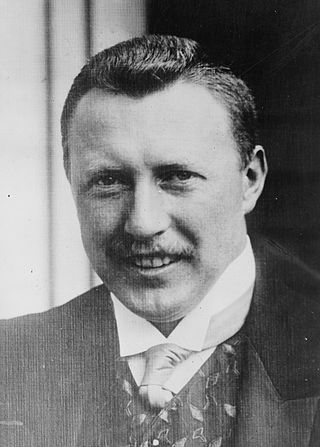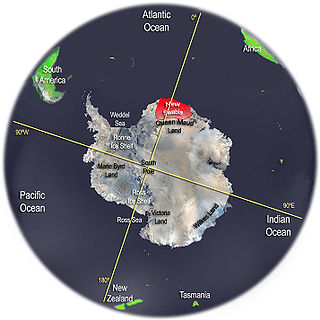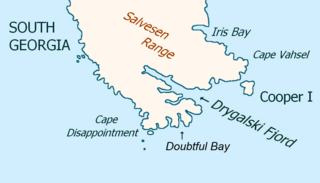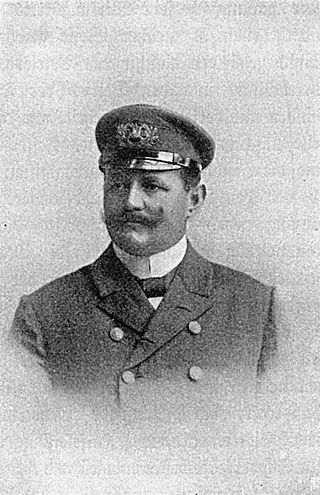
The Filchner–Ronne Ice Shelf or Ronne–Filchner Ice Shelf is an Antarctic ice shelf bordering the Weddell Sea.

Wilhelm Filchner was a German army officer, scientist and explorer. He conducted several surveys and scientific investigations in China, Tibet and surrounding regions, and led the Second German Antarctic Expedition, 1911–13.

New Swabia was a disputed Antarctic claim by Nazi Germany within the Norwegian territorial claim of Queen Maud Land and is now a cartographic name sometimes given to an area of Antarctica between 20°E and 10°W in Queen Maud Land. New Swabia was explored by Germany in early 1939 and named after that expedition's ship, Schwabenland, itself named after the German region of Swabia.
Scott Glacier is a glacier, 7 miles (11.3 km) wide and over 20 miles (32 km) long, flowing north-northwest to the Antarctic coast between Denman Glacier and Mill Island. It was discovered by the Western Base Party of the Australasian Antarctic Expedition (1911–1914) under Mawson and named for Capt. Robert F. Scott.

Queen Mary Land or the Queen Mary Coast is the portion of the coast of Antarctica lying between Cape Filchner, in 91° 54' E, and Cape Hordern, at 100° 30' E. It is claimed by Australia as part of the Australian Antarctic Territory.

Luitpold Coast is that portion of the coast of Coats Land extending from the vicinity of Hayes Glacier, at 27°54′W, to 36°W, which is regarded as the eastern limit of the Filchner Ice Shelf. It was discovered by Wilhelm Filchner, leader of the Second German Antarctic Expedition, 1911–12, and named after Luitpold, Prince Regent of Bavaria.
Vahsel Bay is a bay about 7 miles wide in the western part of the Luitpold Coast, Antarctica.

The Second German Antarctic Expedition of 1911–1913 was led by Wilhelm Filchner in the exploration ship Deutschland. Its principal objective was to determine whether the Antarctic continent comprised a single landmass rather than separated elements, and in particular whether the Weddell Sea and Ross Sea were connected by a strait. In addition, an extensive programme of scientific research was undertaken. The expedition failed to establish a land base, and the ship became beset in the Weddell Sea ice, drifting north for eight months before reaching open water. The expedition was marred by considerable disagreement and animosity among its participants, and broke up in disarray.

Kaiser Wilhelm II Land is a part of Antarctica lying between Cape Penck at 87° 43'E and Cape Filchner at 91° 54'E. Princess Elizabeth Land is located to the west, and Queen Mary Land to the east. The area is claimed by Australia as part of the Australian Antarctic Territory, but like other territorial claims in Antarctica this is not universally recognized.

Cape Vahsel is a headland forming the eastern tip of South Georgia. It was roughly charted by Captain James Cook in 1775, remapped by the Second German Antarctic Expedition under Wilhelm Filchner, 1911–12, and named for Captain Richard Vahsel, master of the expedition ship Deutschland.
Doubtful Bay is a small, deeply indented bay, which lies 1 mile (1.6 km) east-northeast of Smaaland Cove and immediately west of Rumbolds Point on the southeast coast of South Georgia. It was charted by the Second German Antarctic Expedition under Wilhelm Filchner, 1911–12, who named it for Walter Slossarczyk, third officer of the expedition ship Deutschland. Later the names "Doubtful Bay" and "Smaaland Bay" were erroneously transposed on charts of this area. The South Georgia Survey, 1951–52, reported that the name "Slossarczyk Bay" is not known locally and that this feature is best known as Doubtful Bay. Despite the undoubted priority of Filchner's naming, the name Doubtful Bay is approved in order to conform with local usage. The name Slossarczyk Crag has been approved for the elevation at the east side of the Bay.
Schweitzer Glacier is a glacier which drains west along the north side of Littlewood Nunataks into Vahsel Bay. The Lerchenfeld Glacier, trending west-northwestward, coalesces with the lower portion of this glacier. Discovered by the German Antarctic Expedition, 1911–12, under Wilhelm Filchner. He named it for Major Schweitzer, first president of the German Antarctic Expedition Society.
Lewald Glacier is a small glacier 3 nautical miles (6 km) west of Cape Vahsel, flowing northward to the coast at the east end of South Georgia. It was named by the Second German Antarctic Expedition, 1911–12, under Wilhelm Filchner, for Theodor Lewald, Ministerialdirektor im Reichsamt des Innern, Germany, who took an active interest in the expedition.

Posadowsky Glacier is a glacier about 9 nautical miles long, flowing north to Posadowsky Bay immediately east of Gaussberg. Posadowsky Bay is an open embayment, located just east of the West Ice Shelf and fronting on the Davis Sea in Kaiser Wilhelm II Land. Kaiser Wilhelm II Land is the part of East Antarctica lying between Cape Penck, at 87°43'E, and Cape Filchner, at 91°54'E, and is claimed by Australia as part of the Australian Antarctic Territory. Other notable geographic features in this area include Drygalski Island, located 45 mi NNE of Cape Filchner in the Davis Sea, and Mirny Station, a Russian scientific research station.
Purvis Glacier is a glacier flowing generally northeast into the west side of Possession Bay, on the north coast of South Georgia. Charted by the German Antarctic Expedition under Wilhelm Filchner, 1911–12, and named after John Murray-Gletscher. It was renamed Purvis Glacier, possibly to avoid confusion with Murray Glacier in northern Victoria Land, after Petty Officer J. Purvis, Royal Navy.
Salomon Glacier is a glacier flowing south into Hamilton Bay, at the east end of South Georgia. Named by the German Antarctic Expedition under Wilhelm Filchner, 1911–12.
Schrader Glacier is a small glacier which flows to the head of Wilson Harbour on the south coast of South Georgia. Charted by the German Antarctic Expedition under Wilhelm Filchner, 1911–12, and named for Dr. K. Schrader, leader of the German group of the International Polar Year Investigations based at Royal Bay in 1882–83.
Krause Point is a low, ice-covered point in Antarctica, fronting on Davis Sea midway between Cape Torson and Cape Filchner. It was mapped from air photos taken by U.S. Navy Operation Highjump, 1946–47.
The Filchner Rocks are a group of rocks, some of which are submerged, 4 nautical miles (7 km) northeast of Cape Vahsel, off the east end of South Georgia. The existence of these rocks was reported in 1775 by a British expedition under James Cook. They were charted by the Second German Antarctic Expedition, 1911–12, and named for Dr. Wilhelm Filchner, leader of the expedition.

Richard Vahsel was a German naval officer who served as second officer on the Antarctic Gauss expedition, under command of Erich von Drygalski. In 1911, Vahsel was controversially appointed as captain of the Deutschland, on Wilhelm Filchner's Second German Antarctic Expedition, 1911–1913. Vahsel and Filchner proved incompatible, and the failure of their relationship fatally undermined the chances of the expedition's success.









